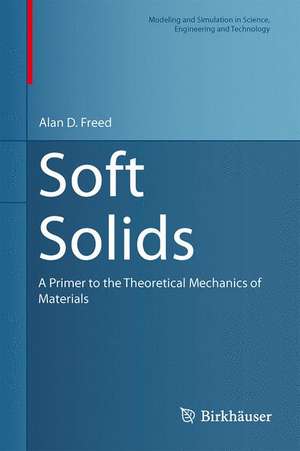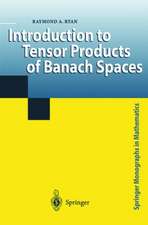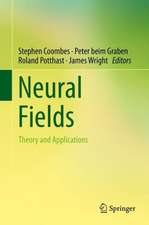Soft Solids: A Primer to the Theoretical Mechanics of Materials: Modeling and Simulation in Science, Engineering and Technology
Autor Alan D. Freeden Limba Engleză Hardback – 26 mar 2014
Soft Solids: A Primer to the Theoretical Mechanics of Materials is divided into two parts. Part I introduces the basic concepts needed to give both Eulerian and Lagrangian descriptions of the mechanical response of soft solids. Part II presents two distinct theories of elasticity and their associated theories of viscoelasticity. Seven boundary-value problems are studied over the course of the book, each pertaining to an experiment used to characterize materials. These problems are discussed at the end of each chapter, giving students the opportunity to apply what they learned in the current chapter and to build upon the material in prior chapters.
| Toate formatele și edițiile | Preț | Express |
|---|---|---|
| Paperback (1) | 460.69 lei 6-8 săpt. | |
| Springer International Publishing – 23 aug 2016 | 460.69 lei 6-8 săpt. | |
| Hardback (1) | 601.27 lei 6-8 săpt. | |
| Springer International Publishing – 26 mar 2014 | 601.27 lei 6-8 săpt. |
Din seria Modeling and Simulation in Science, Engineering and Technology
-
 Preț: 410.88 lei
Preț: 410.88 lei - 18%
 Preț: 958.38 lei
Preț: 958.38 lei - 18%
 Preț: 784.13 lei
Preț: 784.13 lei - 15%
 Preț: 551.02 lei
Preț: 551.02 lei - 15%
 Preț: 642.68 lei
Preț: 642.68 lei -
 Preț: 392.60 lei
Preț: 392.60 lei -
 Preț: 388.34 lei
Preț: 388.34 lei - 18%
 Preț: 950.03 lei
Preț: 950.03 lei - 15%
 Preț: 643.84 lei
Preț: 643.84 lei - 15%
 Preț: 649.39 lei
Preț: 649.39 lei - 15%
 Preț: 644.18 lei
Preț: 644.18 lei - 20%
 Preț: 651.57 lei
Preț: 651.57 lei - 18%
 Preț: 1238.42 lei
Preț: 1238.42 lei - 15%
 Preț: 639.25 lei
Preț: 639.25 lei -
 Preț: 399.12 lei
Preț: 399.12 lei - 15%
 Preț: 650.19 lei
Preț: 650.19 lei -
 Preț: 387.58 lei
Preț: 387.58 lei -
 Preț: 392.97 lei
Preț: 392.97 lei -
 Preț: 396.24 lei
Preț: 396.24 lei - 15%
 Preț: 661.32 lei
Preț: 661.32 lei -
 Preț: 396.24 lei
Preț: 396.24 lei - 18%
 Preț: 943.88 lei
Preț: 943.88 lei - 18%
 Preț: 1386.17 lei
Preț: 1386.17 lei - 15%
 Preț: 648.42 lei
Preț: 648.42 lei - 15%
 Preț: 648.24 lei
Preț: 648.24 lei -
 Preț: 405.06 lei
Preț: 405.06 lei - 15%
 Preț: 641.38 lei
Preț: 641.38 lei - 15%
 Preț: 649.71 lei
Preț: 649.71 lei - 18%
 Preț: 1220.88 lei
Preț: 1220.88 lei - 15%
 Preț: 640.06 lei
Preț: 640.06 lei - 18%
 Preț: 952.26 lei
Preț: 952.26 lei - 15%
 Preț: 640.88 lei
Preț: 640.88 lei -
 Preț: 383.50 lei
Preț: 383.50 lei - 18%
 Preț: 1232.26 lei
Preț: 1232.26 lei - 15%
 Preț: 644.49 lei
Preț: 644.49 lei - 15%
 Preț: 655.60 lei
Preț: 655.60 lei -
 Preț: 400.26 lei
Preț: 400.26 lei - 23%
 Preț: 657.15 lei
Preț: 657.15 lei
Preț: 601.27 lei
Preț vechi: 707.37 lei
-15% Nou
Puncte Express: 902
Preț estimativ în valută:
115.07€ • 119.69$ • 94.99£
115.07€ • 119.69$ • 94.99£
Carte tipărită la comandă
Livrare economică 14-28 aprilie
Preluare comenzi: 021 569.72.76
Specificații
ISBN-13: 9783319035505
ISBN-10: 3319035509
Pagini: 364
Ilustrații: XXXVI, 364 p. 57 illus., 3 illus. in color.
Dimensiuni: 155 x 235 x 22 mm
Greutate: 0.9 kg
Ediția:2014
Editura: Springer International Publishing
Colecția Birkhäuser
Seria Modeling and Simulation in Science, Engineering and Technology
Locul publicării:Cham, Switzerland
ISBN-10: 3319035509
Pagini: 364
Ilustrații: XXXVI, 364 p. 57 illus., 3 illus. in color.
Dimensiuni: 155 x 235 x 22 mm
Greutate: 0.9 kg
Ediția:2014
Editura: Springer International Publishing
Colecția Birkhäuser
Seria Modeling and Simulation in Science, Engineering and Technology
Locul publicării:Cham, Switzerland
Public țintă
GraduateCuprins
Part I: Continuum Fields.- 1 Kinematics.- 2 Deformation.- 3 Strain.-4 Stress.- Part II: Constitutive Equations.- 5 Explicit Elasticity.-6 Implicit Elasticity.- 7 Viscoelasticity.- Appendices.- A Linear Algebra.- B Covariant and Contravariant Issues: Configuration Physics.- C Kronecker Products.- D General Linear ODE Solver.- E Solver for Convolution Integrals.- F Solver for the Mittag-Leer Function.- Bibliography.- Index.
Recenzii
From the book reviews:
“The book starts right at the very beginning of continuum mechanics, i.e., kinematics, deformations, stresses, balances, etc. … The book is meant for seniors and first-year masters students. … It is surely recommendable to researchers working on bio-materials, a field of increasing interest recently.” (Albrecht Bertram, zbMATH, Vol. 1296, 2014)
“The book starts right at the very beginning of continuum mechanics, i.e., kinematics, deformations, stresses, balances, etc. … The book is meant for seniors and first-year masters students. … It is surely recommendable to researchers working on bio-materials, a field of increasing interest recently.” (Albrecht Bertram, zbMATH, Vol. 1296, 2014)
Textul de pe ultima copertă
This textbook presents the physical principles pertinent to the mathematical modeling of soft materials used in engineering practice, including both man-made materials and biological tissues. It is intended for seniors and masters-level graduate students in engineering, physics, or applied mathematics. It will also be a valuable resource for researchers working in mechanics, biomechanics, and other fields where the mechanical response of soft solids is relevant.
Soft Solids: A Primer to the Theoretical Mechanics of Materials is divided into two parts. Part I introduces the basic concepts needed to give both Eulerian and Lagrangian descriptions of the mechanical response of soft solids. Part II presents two distinct theories of elasticity and their associated theories of viscoelasticity. Seven boundary-value problems are studied over the course of the book, each pertaining to an experiment used to characterize materials. These problems are discussed at the end of each chapter, giving students the opportunity to apply what they learned in the current chapter and to build upon the material in prior chapters.
Soft Solids: A Primer to the Theoretical Mechanics of Materials is divided into two parts. Part I introduces the basic concepts needed to give both Eulerian and Lagrangian descriptions of the mechanical response of soft solids. Part II presents two distinct theories of elasticity and their associated theories of viscoelasticity. Seven boundary-value problems are studied over the course of the book, each pertaining to an experiment used to characterize materials. These problems are discussed at the end of each chapter, giving students the opportunity to apply what they learned in the current chapter and to build upon the material in prior chapters.
Caracteristici
Builds upon four experiments through each chapters and includes three additional unsolved experiments Presents a superior new theory of non-linear elasticity describing soft tissues and synthetic elastomers Viscoelasticity is presented from a physics perspective Includes supplementary material: sn.pub/extras













